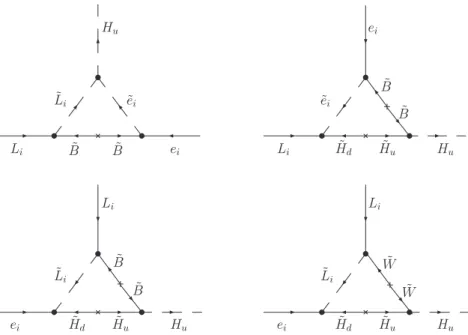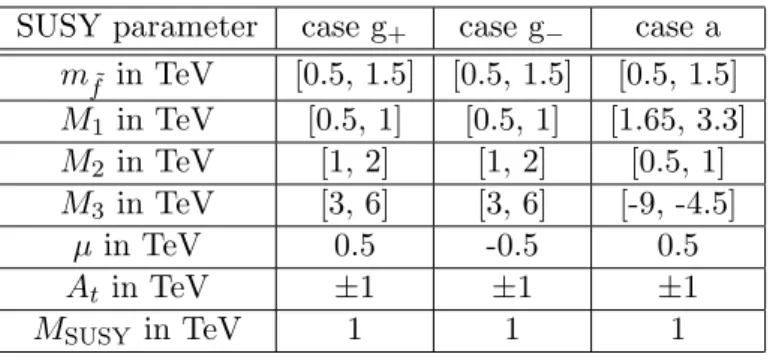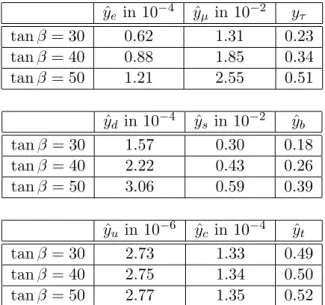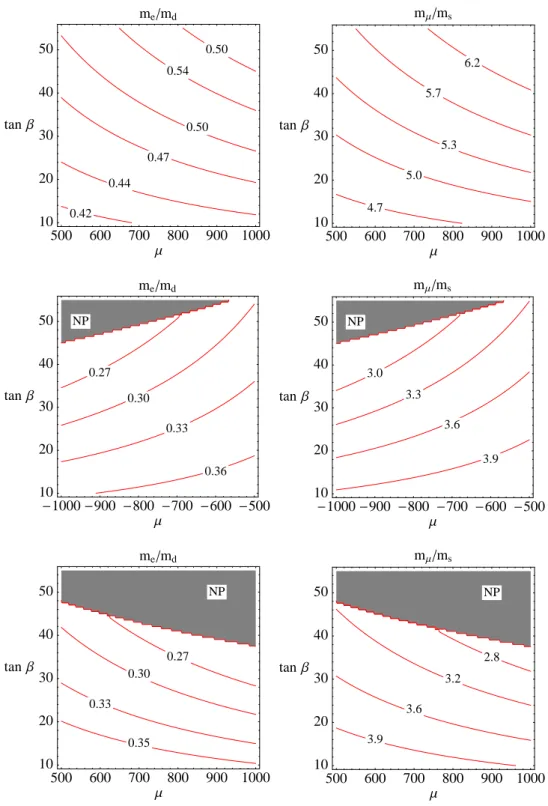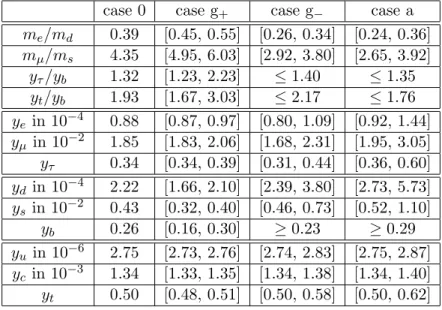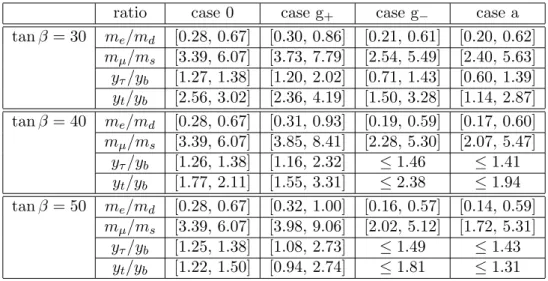MPP-2008-31
Quark and lepton masses at the GUT scale including SUSY threshold corrections
S. Antusch
? 1, M. Spinrath
? 2,
?
Max-Planck-Institut f¨ ur Physik (Werner-Heisenberg-Institut), F¨ ohringer Ring 6, D-80805 M¨ unchen, Germany
Abstract
We investigate the effect of supersymmetric (SUSY) threshold corrections on the values of the running quark and charged lepton masses at the GUT scale within the large tan β regime of the MSSM. In addition to the typically dominant SUSY QCD contributions for the quarks, we also include the electroweak contributions for quarks and leptons and show that they can have significant effects. We provide the GUT scale ranges of quark and charged lepton Yukawa couplings as well as of the ratios m
µ/m
s, m
e/m
d, y
τ/y
band y
t/y
bfor three example ranges of SUSY parameters. We discuss how the enlarged ranges due to threshold effects might open up new possibilities for constructing GUT models of fermion masses and mixings.
1
E-mail: antusch@mppmu.mpg.de
2
E-mail: spinrath@mppmu.mpg.de
arXiv:0804.0717v1 [hep-ph] 4 Apr 2008
1 Introduction
The unification of the fundamental forces of the Standard Model (SM) is one of the guiding principles in the search for a more fundamental theory of nature. In addition to providing a unified origin of the gauge interactions, Grand Unified Theories (GUTs), based e.g. on the gauge symmetry groups SU(5) [1] or SO(10) [2], also unify quarks and leptons of the SM in representations of the unified gauge groups. This property makes them attractive frameworks to address the flavour problem, i.e. the question of the origin of the observed pattern of fermion masses and mixings. Another attractive feature of left-right symmetric GUTs is the appearance of right-handed neutrinos in their particle spectra, which become massive after spontaneous symmetry breaking to the SM and thereby lead to the small observed neutrino masses via the seesaw mechanism [3]. In order to solve the gauge hierarchy problem inherent in high energy extensions of the SM and to make the running gauge couplings meet (at the so-called GUT scale M
GUT≈ 2 × 10
16GeV), the idea of Grand Unification is typically combined with that of low energy supersymmetry (SUSY).
In order to construct successful GUT models of flavour, it is desirable to know the approximate GUT scale values of the quark and lepton masses and mixing parameters.
The experimental data on the masses of the strange quark and the muon, for example, extrapolated to the GUT scale by means of renormalisation group (RG) running within the SM, gave rise to the so-called Georgi Jarlskog (GJ) relations [4] of m
µ/m
s= 3 and m
e/m
d= 1/3 at the GUT scale, which can be realised from a Clebsch-Gordon factor after GUT symmetry breaking. The GJ relations have become a popular building block in many classes of unified flavour models. In SUSY GUTs, another intriguing possibility emerges, which is the unification of all third family Yukawa couplings, i.e. of y
t, y
b, y
τand furthermore, in the context of the seesaw mechanism, of y
νat the GUT scale. To investigate whether this relation can be realised in a given model of low energy SUSY, it is well known that a careful inclusion of SUSY threshold corrections is required [5, 6, 7, 8].
These threshold effects are particularly relevant in the case of large tan β , where y
t= y
b= y
τseems achievable. Despite the possible importance of the SUSY threshold effects, in studies which interpolate the running fermion masses to the GUT scale these effects are typically ignored (see e.g. [9, 10]).
The effects of SUSY threshold corrections on the possibility of third family Yukawa uni- fication y
t= y
b= y
τ(and also on the less restrictive possibility y
b= y
τwhich often emerges in SU(5) GUTs) has been extensively studied in the literature (see e.g. [6, 7, 11, 12, 13]).
Furthermore, recent studies [14] have addressed the phenomenological viability of this rela- tion and have pointed out that under certain assumptions on the soft breaking parameters at the GUT scale, y
t= y
b= y
τmay be already quite challenged by the experimental data from B physics. SUSY threshold effects on the GJ relations have been discussed recently in [15]. Taking into account the typically leading contribution from SUSY QCD loops, it has been shown that the GJ relation can be realised under certain conditions on the SUSY parameters which govern this correction.
The main purpose of this study is to include SUSY threshold corrections and calculate
the possible GUT scale ranges for quark and charged lepton Yukawa couplings as well as for
the ratios m
µ/m
s, m
e/m
d, y
τ/y
band y
t/y
b, which are important input parameter for GUT
model building. Regarding m
µ/m
s, compared to [15] we include additional corrections from electroweak loops with binos and winos for quarks and charged leptons, which, as we will show, can have significant impact. Furthermore, instead of trying to fit the GJ relations by a sparticle spectrum, our aim is to analyse which alternative GUT scale relations may be possible and whether the GJ relation lies within the projected GUT scale ranges. We also investigate other relevant quantities of interest for GUT model building, such as for example the ratio of electron mass over down quark mass, m
e/m
d, and of the third family Yukawa couplings y
t, y
band y
τ.
The remainder of the paper is organised as follows: In section 2 we discuss the various tan β-enhanced contributions to the SUSY threshold corrections and how we implement them within the renormalisation group running procedure of the Yukawa couplings. Section 3 contains our results for the GUT scale ranges for the quark and charged lepton Yukawa couplings as well as for the ratios m
µ/m
s, m
e/m
d, y
τ/y
band y
t/y
band in section 4 we discuss possible implications for GUT model building. Section 5 concludes the paper.
2 SUSY Threshold Corrections
For large tan β in the MSSM it is well known that certain supersymmetric one loop cor- rections are enhanced (see e.g. [5, 6, 7]). The Feynman diagrams corresponding to these one-loop corrections are shown in figures 1 and 2. Q
idenotes the quark doublets, d
iand u
ithe quark singlets, L
ithe lepton doublets and e
ithe lepton singlets of the i-th generation.
H
uis the up-type Higgs doublet, H
dthe down-type Higgs doublet and superpartners are marked with a tilde. For instance, ˜ G labels the gluino with mass M
3, ˜ B the bino with mass M
1and ˜ W the wino with mass M
2.
After matching the SM with the MSSM at the SUSY scale at one loop [16, 17], we obtain for the affected Yukawa couplings of down-type quarks and charged leptons
y
MSSMi= y
SMicos β (1 +
itan β) , (2.1)
where y
SMi= ¯ m
i/v is the SM Yukawa coupling related to the MS-mass ¯ m
iof the respective particle. With v
uand v
dbeing the vacuum expectation values (vevs) of the up-type and down-type Higgs doublets, tan β is defined as tan β = v
u/v
dand the vev v of the SM Higgs is given by v
2= v
2u+ v
d2. The quantities
iwhich govern the tan β-enhanced corrections, with i = d, s, b, e, µ and τ , will be specified in section 2.1. Note that since the calculation is one-loop, we can use MS-quantities as well as DR-quantities. For large tan β the correction
itan β can become quite large, so higher order calculations seem to be necessary, however it can be shown that the tan β-enhanced vertex corrections are absent in higher orders [16].
In the following, we will restrict ourself to the case of large tan β.
For the up-type quarks (and neutrinos) there are no tan β-enhanced corrections, and the remaining corrections are negligibly small. We will therefore match the up-type quark Yukawa couplings using the tree-level relation y
MSSMi= y
SMi/ sin β, with i = u, c and t.
For the neutrino sector we will assume that the small masses are generated by the (type I)
~
B
~
Q
i
~
d
i H
u
Q
i
~
B
~
B
d
i
~
Q
i
~
d
i u
Q
i
d
i
~
G
~
G
~ u
i
~
Q
i u
Q
i
d
i
~
H
u
~
H
d
~
d
i d
i
Q
i
H
u
~
H
d
~
H
u
~
Q
i Q
i
d
i
H
u
~
H
d
~
H
u
~
Q
i Q
i
d
i
H
u
~
H
d
~
H
u
~
B
~
B
~
W
~
B
~
W
Figure 1: Feynman diagrams contributing to the SUSY threshold corrections to down-type quark Yukawa couplings.
seesaw mechanism [3] operating at high energies close to the GUT scale. In the following, we will drop the MSSM-label for the Yukawa couplings and imply y
i≡ y
MSSMi.
2.1 Corrections to Quark and Lepton Yukawa Couplings
We give now explicit formulae for the quantities
iin equation (2.1), which in addition to tan β govern the size of the threshold corrections. Details of the calculation for the quarks can be found in [16, 17]. The formulae are valid for the case of unbroken SU (2)
L× U (1)
Ysymmetry, which is appropriate for the situation that the sparticle masses are in the TeV range and that we use matching conditions at these high energies above the electroweak (EW) scale M
EW.
Turning to the corrections for the down-type quarks we can decompose
i=
Gi+
Bi+
Wi+
yδ
ib, with [18]
Gi= − 2α
S3π µ M
3H
2(u
Q˜i, u
d˜i) , (2.2)
~
L
i
~ e
i u
L
i
~
B
~
B
e
i
~ e
i i
L
i
H
u
~
H
d
~
H
u
~
L
i L
i
e
i
H
u
~
H
d
~
H
u
~
L
i L
i
e
i
H
u
~
H
d
~
H
u
~
B
~
B
~
B
~
B
~
W
~
W
Figure 2: Feynman diagrams contributing to the SUSY threshold corrections to charged lepton Yukawa couplings.
Bi= 1 16π
2"
g
026
M
1µ
H
2(v
Q˜i
, x
1) + 2H
2(v
d˜i
, x
1) + g
029 µ M
1H
2(w
Q˜i
, w
d˜i
)
#
, (2.3)
Wi= 1
16π
23g
22 M
2µ H
2(v
Q˜i
, x
2) , (2.4)
y= − y
t216π
2A
tµ H
2(v
Q˜3, v
u˜3) , (2.5)
where u
f˜= m
2˜f
/M
32, v
f˜= m
2˜f
/µ
2, w
f˜= m
2˜f
/M
12, x
1= M
12/µ
2and x
2= M
22/µ
2for i = d, s, b and where all mass parameters are assumed to be real. The correction
yis only relevant for the b-quarks because of the strong hierarchy of the quark Yukawa couplings.
The function H
2is defined as
H
2(x, y) = x ln x
(1 − x)(x − y) + y ln y
(1 − y)(y − x) . (2.6)
Note that H
2is negative for positive x and y and |H
2| is maximal, if its arguments are minimal, and vice versa.
The corrections for the charged leptons stem from diagrams similar to the ones for the
quarks and are shown in figure 2. One difference between the corrections for quarks and
charged leptons is of course that the SUSY QCD loop contributions
Giare absent. Another
difference concerns the contributions
Biwith binos in the loops, where due to the different
hypercharge of the charged leptons the prefactors for these contributions are changed. In
the last term in equation (2.7) this causes an enhancement by a factor of −9 compared to
the corresponding term in the quark sector in equation (2.3). The contribution from the
diagrams with winos
Wi, on the other hand, is equal for quarks and leptons. A further difference between the corrections for quarks and charged leptons is that in the considered seesaw framework the τ -lepton Yukawa coupling does not have a relevant correction of the
ytype because the corresponding vertex correction is suppressed by the heavy mass scale of the right handed neutrinos. For the corrections for the charged leptons we find
Bi= 1 16π
2"
g
022
M
1µ
−H
2(v
L˜i
, x
1) + 2H
2(v
˜ei, x
1)
− g
02µ M
1H
2(w
L˜i
, w
e˜i)
#
, (2.7)
Wi= 1
16π
23g
22 M
2µ H
2(v
L˜i, x
2) , (2.8)
for i = e, µ, τ .
2.2 Renormalisation Group Running from EW to the GUT Scale
The calculation of the Yukawa couplings of the quarks and charged leptons at the GUT scale can be accomplished by solving the corresponding renormalisation group (RG) equations in the (type I) seesaw scenario from low energy to the GUT scale. For this we use the package REAP introduced in [19], where also a summary of the relevant renormalisation group equations (RGEs) can be found.
For our analysis, we take as input values the running quark and lepton masses at the top scale ¯ m
t( ¯ m
t), which have been calculated recently in [10] with up-to-date experimental values for the low energy quark and charged lepton masses, and evolve them first to the SUSY scale M
SUSYusing the SM RGEs. At the SUSY scale we match the SM with the MSSM to obtain the running MS Yukawa couplings via equation (2.1). Since we consider one-loop running, we can neglect issues of scheme dependence such as transformations from MS to DR quantities. Two-loop running (and scheme dependent) effects are small compared to the tan β-enhanced threshold corrections and can be neglected.
As next step, we solve the RGEs from the SUSY scale to M
GUTtaking into account possible intermediate right-handed neutrino thresholds as discussed in [20]. For our nu- merical calculations we use REAP, which solves the complete set of one-loop RGEs and automatically includes the right-handed neutrino thresholds. We will comment on the pos- sible effects of right-handed neutrino thresholds, which depend on the additional degrees of freedom in seesaw models, in section 3.4. If not stated otherwise, they are ignored in our analysis.
We note that there are SUSY scenarios which may lead to corrections to our approach
of one-step matching at the SUSY scale in the EW unbroken phase. For example, if the
sparticle spectrum is light, effects of EW symmetry breaking may have to be taken into
account for the calculation of the SUSY threshold corrections. Another example is the
possibility of having a (relatively) split sparticle spectrum, in which case matching at one
scale would be a bad approximation. When we present explicit examples in the following,
we choose parameters where our assumptions are justified to a good approximation.
SUSY parameter case g
+case g
−case a m
f˜in TeV [0.5, 1.5] [0.5, 1.5] [0.5, 1.5]
M
1in TeV [0.5, 1] [0.5, 1] [1.65, 3.3]
M
2in TeV [1, 2] [1, 2] [0.5, 1]
M
3in TeV [3, 6] [3, 6] [-9, -4.5]
µ in TeV 0.5 -0.5 0.5
A
tin TeV ±1 ±1 ±1
M
SUSYin TeV 1 1 1
Table 1: Example ranges of SUSY parameters (at the matching scale M
SUSY) used in our analyses in sections 3.1 and 3.5. The choices of gaugino masses in the cases g
±are inspired by universal gaugino masses at the GUT scale and in case a by anomaly mediated SUSY breaking. We therefore use the low energy approximation M
1: M
2: M
3= 1 : 2 : 6 for the cases g
±and M
1: M
2: M
3= 3.3 : 1 : −9 for case a as a constraint.
3 Quark and Lepton Yukawa Couplings at the GUT Scale
In this part we present our analytical and numerical results. We start with a semi-analytic discussion of the individual contributions to the threshold corrections presented in equations (2.2) to (2.8), which allows to estimate their size as well as the size of the total corrections
i. We will then turn to the numerical analysis, where we quantitatively discuss the effect of the most relevant parameters and present our final results for the quark and charged lepton Yukawa couplings (and mass ratios
1) at the GUT scale. To isolate the effects of the SUSY (MSSM) parameters from the uncertainties induced by the quark mass errors, we first use best-fit values for the low energy fermion masses. These errors are later included in our final results presented in tables 6 and 7. We note that the quark mass errors have a significant effect, whereas the charged lepton mass errors are negligibly small.
3.1 Semi-Analytical Approach
For our semi-analytical approach we first define three example choices of possible ranges of the relevant SUSY breaking parameters. They are listed in table 1 and will be referred to as cases g
+, g
−and a. The cases g
+and g
−are inspired by scenarios with universal boundary conditions for the gauginos (where M
1/g
21= M
2/g
22= M
3/g
32) and case a by anomaly mediated SUSY breaking [21, 22] (where M
1/(g
12β
1) = M
2/(g
22β
2) = M
3/(g
32β
3), with (β
1, β
2, β
3) = (33/5, 1, −3)). We note that instead of these relations at the SUSY scale, we use the low energy approximation M
1: M
2: M
3≈ 1 : 2 : 6 for the cases g
±and M
1: M
2: M
3≈ 3.3 : 1 : −9 for case a. We furthermore only introduce relations for the gaugino masses, whereas for the sfermion masses m
f˜and the µ and A
tparameters we do not apply restrictions from a specific model of SUSY breaking. The example ranges are chosen such that we can neglect effects which are suppressed by M
EW/M
SUSY, such
1
We note that when we refer to fermion masses at the GUT scale, what we mean is simply the Yukawa
coupling multiplied by the low energy value of the corresponding Higgs vev.
case g
+case g
−case a
Giin 10
−3[3.52, 9.31] [-9.31, -3.52] [-7.85, -3.10]
Bifor quarks in 10
−3[-0.31, -0.08] [0.08, 0.31] [-0.30, -0.16]
Bifor leptons in 10
−3[-0.18, 0.30] [-0.30, 0.18] [0.01, 0.30]
Wiin 10
−3[-2.21, -0.98] [0.98, 2.21] [-2.21, -0.72]
yin 10
−3sign(A
t) [0.84, 4.65] -sign(A
t) [0.84, 4.65] sign(A
t) [0.84, 4.65]
Table 2: Ranges for the various contributions to the SUSY threshold corrections (corresponding to the example ranges of SUSY parameters in table 1) for i = d, s, b and i = e, µ, τ , respectively. For the charged leptons there is no contribution
Giand
y. The ranges for
Wiare the same for quarks and leptons.
as mixing between left- and right-handed sfermions, and that our approach of one-step matching is justified to a good approximation. We also note that without specifying the remaining SUSY parameters (which do not enter the formulae for the threshold corrections) we cannot apply various relevant phenomenological constraints on the spectrum. To do so, we would have to impose further constraints on the soft breaking parameters (as done e.g.
in [14]) which is, however, not our intention.
For the parameter ranges specified in table 1, we can estimate the corresponding ranges for the different components of
i. Scanning over the ranges of SUSY parameters in table 1 we obtain the resulting ranges presented in table 2. The gauge couplings are evaluated at the SUSY scale. From these ranges we can already see that the electroweak contributions cannot be neglected. In our scan we find that they can amount up to about 50 % of the QCD contribution, larger than one might suspect from table 1 due to correlations between the corrections. We can also see from table 2 that, for the quarks, in case a the inclusion of the electroweak corrections results in an enlargement of the threshold correction because here the QCD and the electroweak corrections add up, whereas in case g
±it results in a reduction of the total correction because both contributions partially cancel.
The ranges for the
ifrom table 2 can now be used to obtain (naive) analytic estimates for the ratios of the fermion masses (or Yukawa couplings) at the GUT scale. For example, in leading order the GUT scale ratio m
e/m
dis given by
m
e(M
GUT)
m
d(M
GUT) ≈ m ˆ
e(M
GUT) ˆ
m
d(M
GUT)
1 +
dtan β
1 +
etan β = m ˆ
e(M
GUT) ˆ
m
d(M
GUT) (1 + (
d−
e) tan β ) + O(
2etan
2β), (3.9) where ˆ m(M
GUT) denotes the fermion masses at the GUT scale without SUSY thresholds.
We will use the analogous formula for the second generation. For the third generation we
take the ratios of the Yukawa couplings so we have to take into account an additional tan β
factor for y
t/y
b. We will later on compare these estimates with the numerical results for
the same ranges of MSSM parameters (c.f. table (5)). For the values of the masses and
Yukawa couplings at the GUT scale, we take the values calculated with REAP setting all
SUSY threshold corrections to zero and using the best-fit values for the fermion masses as
low energy input. These values for the Yukawa couplings are collected in table 3. In the
following (e.g. in table 4) we will refer to the case without SUSY thresholds as case 0.
ˆ
y
ein 10
−4y ˆ
µin 10
−2y
τtan β = 30 0.62 1.31 0.23
tan β = 40 0.88 1.85 0.34
tan β = 50 1.21 2.55 0.51
ˆ
y
din 10
−4y ˆ
sin 10
−2y ˆ
btan β = 30 1.57 0.30 0.18
tan β = 40 2.22 0.43 0.26
tan β = 50 3.06 0.59 0.39
ˆ
y
uin 10
−6y ˆ
cin 10
−4y ˆ
ttan β = 30 2.73 1.33 0.49
tan β = 40 2.75 1.34 0.50
tan β = 50 2.77 1.35 0.52
Table 3: Best fit values for the Yukawa couplings at the GUT scale without SUSY threshold corrections (case 0) for M
SUSY= 1 TeV and different values of tan β.
case 0 case g
+case g
−case a m
e/m
d0.39 [0.35, 0.64] [0.15, 0.44] [0.16, 0.44]
m
µ/m
s4.35 [3.83, 7.01] [1.69, 4.87] [1.81, 4.85]
y
τ/y
b1.32 [1.16, 2.13] ≤ 1.48 ≤ 1.47 y
t/y
b1.93 [1.65, 2.92] ≤ 2.21 ≤ 1.98
Table 4: Semi-analytic (naive) estimates for the ranges of the mass and Yukawa coupling ratios at the GUT
scale (corresponding to the example ranges of SUSY parameters in table 1) for tan β = 40. Case 0 refers
to the case without SUSY threshold corrections. For the ranges involving y
b, the lower boundaries depend
on the cut we had to introduce in order to keep y
bnon-perturbative up to M
GUTand therefore have been
omitted.
The results of these estimates are collected in table 4. We note that these estimates are naive in the sense that we have combined the maximal and minimal values of each of the contributions to
i, neglecting possible correlations between them. For example, we do not account for the effect that the QCD corrections become large, if M
3and thus the gaugino masses are large and the sfermion masses small, whereas the wino corrections become large, if the gaugino masses and the sfermion masses are small. However, as we will later see, the estimates nevertheless work surprisingly well. Another effect which we can immediately see from the analytic estimates is that y
bcan become non-perturbatively large if
btan β is large and negative. In fact, it can even occur that
itan β ≤ −1, which spoils the perturbative expansion. Wherever non-perturbative values of y
boccur, we only give the upper boundaries of the ranges y
τ/y
band y
t/y
band the lower boundary for y
bitself.
The naive estimates already suggest that with SUSY thresholds included, a wide range of GUT scale values of down-type quark and charged lepton masses (or Yukawa couplings) could be realised. Taking a preliminary look at the predicted ratio for m
µ/m
s, the naive estimates suggest that with the SUSY parameters of example g
+, the GUT scale value of m
µ/m
sis typically significantly larger than the GJ relation of m
µ/m
s= 3. On the other hand, scenario g
−and a are well compatible with the GJ relation. Beyond the GJ relation, the naive estimates also imply that with SUSY thresholds included, a large variety of GUT model predictions for these ratios might be compatible with the low energy data on quark and lepton masses. A full numerical analysis for the example SUSY parameter ranges g
±and a will be presented in section 3.5.
3.2 Dependence on µ and tan β
Before we proceed with the numerical analysis for the example ranges of MSSM para- meters of table 1, we discuss the dependence on µ and tan β, which has been kept fixed in the last section. The dependence on µ is rather important, because all corrections are proportional to µ or 1/µ. The parameter µ therefore gives the overall sign of the corrections and determines, if the Yukawa couplings are enhanced or reduced by the SUSY threshold effects. In addition, tan β is very important because the threshold corrections are almost linear in tan β and also because for successful third family Yukawa unification we need a large value of tan β. To isolate the effects of these parameters, we have effectively turned off the right-handed neutrino threshold effects, put A
tto zero and all the other soft SUSY breaking parameters and the SUSY scale to 1 TeV (with both signs allowed for M
3but with M
1> 0, M
2> 0). In figures 3 and 4 the numerical results are presented as contour plots in the µ-tan β plane for the four ratios m
e/m
d, m
µ/m
s, y
τ/y
band y
t/y
bfor different combinations of the sign of µ and M
3.
There are several interesting points we would like to remark: Firstly, the overall de-
pendence in the plots illustrates the anticipated behaviour from the fact that the leading
contribution from gluino loops is proportional to µ and that the overall size of the correc-
tions is proportional to tan β. They also illustrate that for µM
3< 0 (second and third rows
in the figures) the total corrections enhance the down-type quark Yukawa couplings leading
to more stringent restrictions for the possible values of tan β from perturbativity of y
bup
to the GUT scale. On the other hand, for µM
3> 0 and M
3> 0 (first row in the figures)
500 600 700 800 900 1000 Μ
10 20 30 40 50
tan Β
m
em
d0.42 0.44
0.47 0.50 0.54
0.50
500 600 700 800 900 1000 Μ
10 20 30 40 50
tan Β
m
Μm
s4.7 5.0
5.3 5.7
6.2
-1000 -900 -800 -700 -600 -500 Μ
10 20 30 40 50
tan Β
m
em
d0.27 0.30
0.33
0.36 NP
-1000 -900 -800 -700 -600 -500 Μ
10 20 30 40 50
tan Β
m
Μm
s3.0 3.3
3.6 3.9 NP
500 600 700 800 900 1000 Μ
10 20 30 40 50
tan Β
m
em
d0.27 0.30 0.33
0.35
NP
500 600 700 800 900 1000 Μ
10 20 30 40 50
tan Β
m
Μm
s2.8 3.2 3.6 3.9
NP
Figure 3: Contour plots for the GUT scale ratios m
e/m
d(left side) and m
µ/m
s(right side) for M
3> 0,
µ > 0 (first row), M
3> 0, µ < 0 (second row) and M
3< 0, µ > 0 (third row) in the µ-tan β plane. In the
grey areas labeled with NP the value of y
bbecomes non-perturbatively large.
500 600 700 800 900 1000 Μ
10 20 30 40 50
tan Β
y
Τy
b1.45 1.52
1.62 1.75 1.90
2.10
500 600 700 800 900 1000 Μ
10 20 30 40 50
tan Β
y
ty
b1.8 2.2
2.8 3.8
5.5
-1000 -900 -800 -700 -600 -500 Μ
10 20 30 40 50
tan Β
y
Τy
b0.8 1.0
1.1 1.2 NP
-1000 -900 -800 -700 -600 -500 Μ
10 20 30 40 50
tan Β
y
ty
b0.7 1.2 1.8 2.5 3.5 5.2 NP
500 600 700 800 900 1000 Μ
10 20 30 40 50
tan Β
y
Τy
b0.75 0.90 1.00 1.10 1.20
NP
500 600 700 800 900 1000 Μ
10 20 30 40 50
tan Β
y
ty
b0.9 1.5 2.2 3.2 4.8
NP
Figure 4: Contour plots for the GUT scale ratios y
τ/y
b(left side) and y
t/y
b(right side) for M
3> 0, µ > 0
(first row), M
3> 0, µ < 0 (second row) and M
3< 0, µ > 0 (third row) in the µ-tan β plane. In the grey
areas labeled with NP the value of y
bbecomes non-perturbatively large.
the total corrections lower the down-type quark masses and in principle larger values for tan β are possible. Secondly, interesting conclusions can also be drawn from comparing the second to the third row of the figures. From the leading SUSY QCD contribution which is invariant under a simultaneous change of sign in µ and M
3, one might expect that the plots in the second and third rows look very similar (if understood as results for |µ|). Differences are entirely induced by the contributions from wino and bino loops, since we have chosen A
t= 0. Inspecting the numerical results shows significant differences in the results for µ < 0 and M
3> 0 and µ > 0 and M
3< 0, which confirms that the EW contributions are indeed important and cannot be ignored (as we have already concluded from our semi-analytic estimates in section 3.1).
3.3 Dependence on M
SUSYand A
tThe GUT scale values of the quark and lepton Yukawa couplings also depend on M
SUSYand A
t. While the correction to the bottom Yukawa coupling can be significant (as can be seen from table 2), the effects on the down and strange quark Yukawa couplings are quite weak since they only stem from indirect effects (modified RG evolution) due to the change of the bottom Yukawa coupling.
We also looked explicitly at the dependence on M
SUSYby fixing all other parameters and varying only M
SUSY. We found that changing M
SUSYcan have some effect on the GUT scale value of the Yukawa couplings due to the difference in the RGEs between SM and MSSM, however this effect is typically much smaller than the uncertainty induced by the quark mass errors and the sparticle spectrum and it nearly cancels out when we consider ratios of masses or Yukawa couplings. We have therefore fixed M
SUSYto 1 TeV in our numerical examples.
3.4 Right-handed Neutrino Threshold Effects
For analysing the possible dependence on threshold effects from the right-handed neutrino sector, we have taken the three examples for SUSY parameters from our analysis on the µ and tan β dependence, but fixed µ to ±0.5 TeV and tan β to 40. For these example param- eter points we have investigated the effects for the three different scenarios of sequential dominance [23] also used as examples in [24]. With largest neutrino Yukawa couplings being O(1), we found that the deviations are typically smaller than 5 %, which is small compared to the SUSY threshold effects (in our examples) and also compared to the uncertainties induced by the present quark mass errors, especially for the first and second generation.
3.5 Impact of the Sparticle Spectrum
As already stated in the previous sections, the GUT scale values of the quark and lepton
Yukawa couplings (and masses) strongly depend on the sparticle spectrum. We will now
analyse its impact numerically in more detail. Because of the large number of relevant
parameters, we do not attempt to discuss each of them separately, but rather make a
parameter scan.
For our scan, we take the three example ranges of SUSY parameters used for our ana- lytical estimates in section 3.1, which are listed explicitly in table 1. In addition, for tan β we assume a range from 30 to 50. The sfermion mass parameters and A
tare scanned with a step size of 1 TeV (including A
t= 0), the mass of the lightest gaugino was changed with a step size of 0.5 TeV and tan β is scanned with a step size of 10. The parameter points for which y
bbecomes non-perturbative have been dropped from our analysis. We note that for simplicity we have introduced a slightly more restrictive cut and included only parameter points where y
b< 1 at M
SUSY(which ensures perturbativity up to M
GUTbut eventually removes a few allowed parameter points with large but non-perturbative y
b). Furthermore we have chosen M
SUSYto be 1 TeV. The masses of the first two sfermion generations have been assumed identical, which is inspired by universal high scale boundary conditions for sfermions. We note that a small mass splitting does not change the conclusions from this plot, however a large mass splitting can reduce the threshold effects due to a reduced value of the function |H
2| in the formulae (2.2) to (2.8).
The results of our parameter scans are presented as scatter plots in figure 5. For com- parison we have also included the best fit values, which would be obtained without SUSY threshold effects. It can be seen that, with SUSY threshold corrections included, the shown ratios are (for almost all parameter points) significantly shifted to large values for case g
+and to smaller values for case g
−and a.
The plots also reveal some interesting features, which we discuss now. For example we notice that small values for m
µ/m
sare correlated (nearly linearly) to small values of m
e/m
d. This correlation is connected to our assumption that the sfermion masses of the first two families are assumed to be identical. Looking next at the third family relations y
τ/y
bversus y
t/y
b, we find that there is an additional tan β-dependence, which is due to the fact that the relation of top mass and Yukawa coupling differs from the relations for down- type quarks and charged leptons by a factor of tan β. For all three cases we can therefore distinguish three bands, which correspond to the three values of tan β in our parameter scan. The scans show that for case g
−and a it is in principle possible to obtain third family Yukawa unification for tan β ≈ 50 (in fact for tan β somewhat below 50 in case a), whereas for g
+we found that it could not be exactly realised. Although y
b≈ y
tcan be achieved for tan β = 50, A
t= −1 TeV, µ = 0.5 TeV, light gaugino masses, m
d˜3= 1.5 TeV and m
Q˜3
= m
˜u3= 0.5 TeV, we found y
τ/y
b& 1.2 in the considered parameter range. However, we would like to note that quark mass errors are not yet included in this plot and that their inclusion may allow for consistent y
t= y
b= y
τ(c.f. tables 6 and 7).
We note that since we have not specified the remaining SUSY parameters (which do not enter the formulae for the threshold corrections) we have not applied various relevant phenomenological constraints on the spectrum. We would therefore like to warn the reader that for additional assumptions for the SUSY parameters some of the considered parameter points may be phenomenologically challenged already by the present experimental data (e.g.
from B physics, g
µ−2 or from LFV charged lepton decays in seesaw scenarios). In particular the cases with |A
t| = 1 TeV may (under some conditions) be challenged by B → µ
+µ
−data and the case µ < 0 (and M
2> 0) may seem already disfavoured by g
µ− 2 if the assumption is made that the ( & 3σ) deviation from the SM prediction is restored by SUSY loop effects.
The ranges for the quark and lepton Yukawa couplings at the GUT scale and for the
0.2 0.3 0.4 0.5 0.6 m
e
m
d2 3 4 5 6
m
Μ
m
s0.5 1 1.5 2 2.5
y
Τ
y
b0.5 1 1.5 2 2.5 3 3.5 4
y
t
y
btanΒ =50 tanΒ =40
tanΒ =30
0.2 0.3 0.4 0.5 0.6 m
e
m
d2 3 4 5 6
m
Μ
m
s0.5 1 1.5 2 2.5
y
Τ
y
b0.5 1 1.5 2 2.5 3 3.5 4
y
t
y
btanΒ =50 tanΒ =40 tanΒ =30
0.2 0.3 0.4 0.5 0.6 m
e
m
d2 3 4 5 6
m
Μ
m
s0.5 1 1.5 2 2.5
y
Τ
y
b0.5 1 1.5 2 2.5 3 3.5 4
y
t
y
btanΒ =50 tanΒ =40 tanΒ =30

